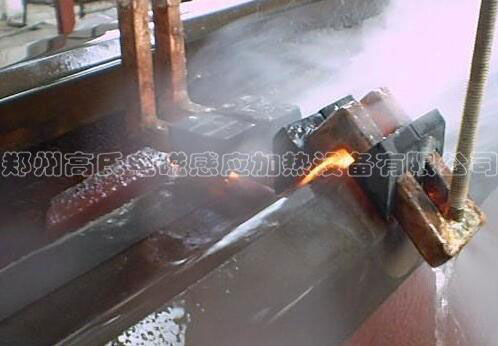
The guide rail is an important part of the lathe. Bed rails are required to have high hardness, high strength, high wear resistance, small deformation, good vibration damping and good dimensional stability. Rail material is HT200 (or HT300). Previously, the electric contact heating self-cooling and quenching process was used. During the production, it was found that the performance of the guide rail was unstable, the hardness was uneven and the deformation was large, which made it difficult to meet the technical requirements and affected the product quality and machine tool production. For this reason, the test was changed to medium-frequency induction heating and quenching of the guide rail. After process improvement and quality control, the quality of the workpiece met the technical requirements, and the deformation amount was less than 0.40mm, and it has been successfully applied in production.
In order to eliminate casting and cold working stress and stabilize the organization to reduce rail deformation, preparatory heat treatment can be carried out. Usually, the induction heating and quenching deformation of the guide rail shows a concave deformation in the middle. In order to control the final deformation of the guide rail within a small range, the reverse pre-deformation method is adopted, and the middle part of the guide rail is raised by 0.40-0.50mm after fine planing. At the same time, the reverse stress shape is pre-added on the quenching machine tool, that is, the two ends of the guide rail are pressed, and the middle part is used to jack up the guide rail. The total amount of reverse deformation is about 1.0mm in the middle. In this way, after the workpiece is quenched, the concave amount of the guide rail is less than or equal to 0.40mm, which meets the technical requirements.
Intermediate frequency induction heating and quenching is the key heat treatment process. Since the heating depth of the medium frequency induction heating machine is 3-6mm, the quenching stress and deformation are large, and cracks are easy to occur, so the selection and operation of process parameters should be strictly controlled. Inductive heating should consider the induced current generated at the tip of the guide rail. Due to the strong ring effect and sharp corner effect of the inductor heating, it is easy to overheat the workpiece due to the concentration of the induced current. This point should be avoided in the design of the inductor. Therefore, in addition to the profiling design of the inductor and the guide rail section, the gap between the inductor and the guide rail should be uneven, so that the induction heating is almost uniform on the entire guide rail; The gap is 3-3.5mm. The water spray hole diameter of the sensor is 1.5mm in diameter, the hole distance is 4mm, the water spray hole angle is about 45°, and the cooling water temperature is about 50°C. After testing, the temperature for induction hardening by medium frequency induction heating machine is 850°C±10°C. If the temperature is too high, the martensite of the workpiece will be coarse and the retained austenite will increase. Quenching cracks appear. The hardness of the guide rail after intermediate frequency induction heating and quenching is 48.5-50.0HRC, and the hardness after grinding is 54-55.5HRC, which meets the technical requirements (48.5-56HRC); the structure after quenching is qualified, and the structure is martensite + retained austenite + graphite + A small amount of cementite, phosphorus eutectic, etc., equivalent to Martensitic grade 4 structure, the depth of the hardened layer of the workpiece ≥ 2.5mm, the maximum deformation of the guide rail after induction heating and quenching (concave bending) ≤ 0.40mm, no The soft point tire defect fully complies with the technical requirements of the machine tool.
Many manufacturers use the above process for heat treatment, and the quality of the lathe guide rails produced is good, which meets their work needs. Of course, in the actual operation process, if you encounter any problems, you can consult our technical staff.




 en
en  cn
cn  jp
jp  ko
ko  de
de  es
es  it
it  ru
ru  pt
pt  vi
vi  th
th  pl
pl 








 GS-ZP-1200
GS-ZP-1200


